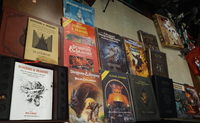Formal Activity Analysis of Different Role-Playing Games, Including Different D&D Versions.
In the field of Recreational Therapy, activity analysis is s standard part of the assessment process for Therapeutic Recreation Specialist professionals. We have used these techniques for years to best match activities to clients' needs as effectively as possible.
Regarding the different versions of D&D and other role-playing games pros and cons, we are sharing with the public during our regularly scheduled streaming broadcasts of RPG Theory on Sundays & Mondays., detailed Activity Analysis of each of the D&D versions, from OD&D through 5e.
Last week we performed an initial introduction to the topics of Activity Analysis, Task Analysis, etc., including caveats about any validity and reliability issues with these assessment tools.
https://www.patreon.com/posts/26510182
These videos are broadcast live to the public, and then the recorded versions are made available to our "Hero Level" Patreon supporters as a thank you for supporting the 501(c)3 non-profit RPG Research, and then released to the general public 4+ weeks after.
Next week we'll start with OD&D & BECMI, and then in subsequent weeks the other versions.
https://www.youtube.com/rpgresearch
Over time we will share the same with many other role-playing games as well.
Document Actions

